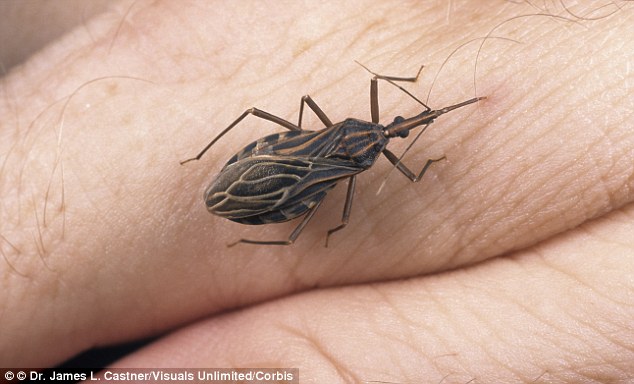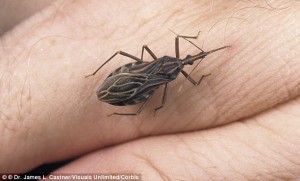A little-known life-threatening illness caused by blood sucking insects has been labeled the “New AIDS of the Americas” by leading health experts.
The said disease was once largely contained to Latin America but is now spreading into the United States due to the increases in travel and migration. Chagas is usually transmitted from the bite of blood-sucking insects called Triatome bugs which release a parasite called Trypanosoma cruzi into the victim’s bloodstream.
According to a report, the parasitic illness called Chagas Disease has similarities to the early spread of HIV. The shocking comparison has put this neglected tropical disease in headlines around the world.
Who’s at risk? Is Chagas really as bad as AIDS? Before fear runs rampant, it’s important to know the facts.
What Is Chagas Disease?
Chagas disease is caused by a parasite called Trypanosoma cruzi. The parasites multiply within cells of the body. Infected cells burst, releasing parasites into the bloodstream.
Chagas disease was first recognized in the modern era by Brazilian doctor Carlos Chagas in 1909. But the disease has been around for 9,000 years. Chagas parasites have been found in the remains of mummies from the ancient Chinchorro culture of South America. The most common complication of chronic Chagas disease is a heart condition called chronic Chagas cardiopathy.
These complications include enlarged heart, heart failure, severely altered heart rhythm, and heart attack.
Some patients with chronic Chagas disease get intestinal complications. These may include enlarged esophagus (causing difficulty swallowing) or enlarged colon (causing difficulty passing stool).
How Is Chagas Disease Spread?
There are several ways Chagas disease is spread.
The most common way is through the bite of a family of blood-sucking insects called triatomes. They’re better known as kissing bugs, assassin bugs, cone-nosed bugs, and reduviid bugs.
Chagas Disease: ‘AIDS of the Americas’? While most cases of Chagas disease are in Central and South America, 11 different species of the bugs live in the Southern U.S. They may be found as far north as Pennsylvania in the East and Northern California in the West.
Inside houses, the most common places to find the bugs are near pet resting areas (a good reason not to sleep with your pets), in areas infested by rodents, and in or around beds (particularly under mattresses or bedside tables).
These bugs usually come out at night. They feed on the blood of humans and other mammals, birds, and reptiles. The bugs are attracted to the lips — hence the nickname “kissing bug” — although bites may occur on other parts of the body.
The bug bite itself doesn’t spread Chagas parasites. But while feeding, bug droppings are left near the wound. When these droppings get into the wound or mucous membranes (as when a person touches the droppings and then rubs his or her eye), the parasites enter the body.
Chagas can also be spread:
By getting a blood transfusion or organ transplant from an infected person.
By eating undercooked foods contaminated with infected bugs or their droppings.
By eating undercooked game infected with Chagas parasites.
From mother to child during pregnancy or during breastfeeding.
In laboratory accidents.
In South America, people have been infected with Chagas parasites through contaminated cane juice, acai juice, guava juice, and palm wine.
While the burden of Chagas disease falls mainly on people in Central and South America, the disease is spreading worldwide. Cases have been seen in Japan and Western Europe. And Chagas is becoming more of a problem in the Southern U.S., particularly in Texas and the Gulf Coast.
What Are the Symptoms of Chagas Disease?
People with acute-phase Chagas disease may not have any symptoms at all. Mild symptoms of acute Chagas disease are similar to other illnesses: fever, fatigue, body aches, headache, rash, loss of appetite, diarrhea, and vomiting.
One unique sign of Chagas disease is called Romaña’s sign: swelling of the eyelids and around the eye on the side of the face near the bite or where infected bug droppings have been rubbed into the eye.
But these acute-phase symptoms usually go away on their own even though the infection does not.
When chronic symptoms occur, they are the symptoms of severe heart disease or severe intestinal disease.
What Is the Treatment for Chagas Disease?
Children and adults under age 50 should be treated as soon as possible after infection with Chagas parasites. For adults 50 and older, treatment decisions should be individualized based on age, health, and personal preference.
Treated early enough, the disease can be cleared in most children and in about 80% of adults. Even when treatment does not totally eliminate the parasite, it can greatly reduce the odds of severe chronic disease.
There are only two drugs used to treat Chagas disease: nifurtimox and benznidazole. Neither of these drugs is approved by the FDA and, in the U.S., must be obtained by doctors through the CDC.
Treatment must continue for 60 to 90 days. Side effects, some of them severe, are common.
Some 9 million people worldwide have Chagas disease, with about 20 percent to 40 percent suffering from chronic disease. Both drugs used to treat the disease are in short supply. Even when they are available, the cost of treatment can be as high as $1,000 or more.
Why Is Chagas Compared To AIDS?
In some ways, the comparison of Chagas to AIDS is unfortunate.
Unlike HIV, the AIDS virus, Chagas parasites cannot be spread via sex. Untreated HIV infection is almost always fatal, while 70 percent to 80 percent of people with Chagas disease do not develop severe heart disease.
But Chagas disease does share some features with AIDS:
Both are diseases of poverty. In the Americas, Chagas is mainly a problem of the “bottom 100 million” people who suffer from at least one of the so-called neglected tropical diseases.
Both diseases carry significant stigma. In the U.S., undocumented workers infected with Chagas disease may not seek treatment due to fear of deportation.
Both diseases are treated with drugs that are in short supply.
Both diseases are treated with expensive drugs.
Lack of access to medical care complicates both the Chagas and AIDS epidemics.
There is no vaccine either for Chagas disease or for HIV/AIDS.
Whether Chagas disease really is the “AIDS of the Americas,” as Baylor College of Medicine’s Peter J. Hotez, MD, PhD, and colleagues suggest, is in the eye of the beholder.


